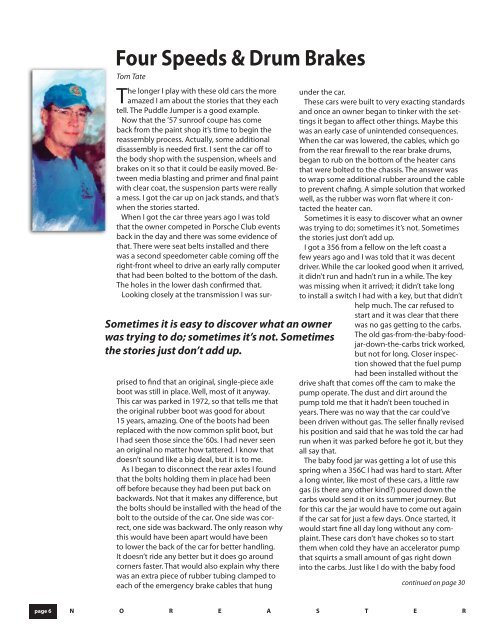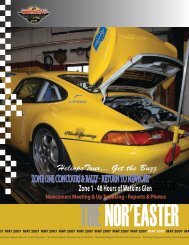July - Porsche Club of America â Northeast Region
July - Porsche Club of America â Northeast Region
July - Porsche Club of America â Northeast Region
You also want an ePaper? Increase the reach of your titles
YUMPU automatically turns print PDFs into web optimized ePapers that Google loves.
Four Speeds & Drum Brakes<br />
Tom Tate<br />
Sometimes it is easy to discover what an owner<br />
was trying to do; sometimes it’s not. Sometimes<br />
the stories just don’t add up.<br />
The longer I play with these old cars the more<br />
amazed I am about the stories that they each<br />
tell. The Puddle Jumper is a good example.<br />
Now that the ’57 sunro<strong>of</strong> coupe has come<br />
back from the paint shop it’s time to begin the<br />
reassembly process. Actually, some additional<br />
disassembly is needed first. I sent the car <strong>of</strong>f to<br />
the body shop with the suspension, wheels and<br />
brakes on it so that it could be easily moved. Between<br />
media blasting and primer and final paint<br />
with clear coat, the suspension parts were really<br />
a mess. I got the car up on jack stands, and that’s<br />
when the stories started.<br />
When I got the car three years ago I was told<br />
that the owner competed in <strong>Porsche</strong> <strong>Club</strong> events<br />
back in the day and there was some evidence <strong>of</strong><br />
that. There were seat belts installed and there<br />
was a second speedometer cable coming <strong>of</strong>f the<br />
right-front wheel to drive an early rally computer<br />
that had been bolted to the bottom <strong>of</strong> the dash.<br />
The holes in the lower dash confirmed that.<br />
Looking closely at the transmission I was surprised<br />
to find that an original, single-piece axle<br />
boot was still in place. Well, most <strong>of</strong> it anyway.<br />
This car was parked in 1972, so that tells me that<br />
the original rubber boot was good for about<br />
15 years, amazing. One <strong>of</strong> the boots had been<br />
replaced with the now common split boot, but<br />
I had seen those since the ‘60s. I had never seen<br />
an original no matter how tattered. I know that<br />
doesn’t sound like a big deal, but it is to me.<br />
As I began to disconnect the rear axles I found<br />
that the bolts holding them in place had been<br />
<strong>of</strong>f before because they had been put back on<br />
backwards. Not that it makes any difference, but<br />
the bolts should be installed with the head <strong>of</strong> the<br />
bolt to the outside <strong>of</strong> the car. One side was correct,<br />
one side was backward. The only reason why<br />
this would have been apart would have been<br />
to lower the back <strong>of</strong> the car for better handling.<br />
It doesn’t ride any better but it does go around<br />
corners faster. That would also explain why there<br />
was an extra piece <strong>of</strong> rubber tubing clamped to<br />
each <strong>of</strong> the emergency brake cables that hung<br />
under the car.<br />
These cars were built to very exacting standards<br />
and once an owner began to tinker with the settings<br />
it began to affect other things. Maybe this<br />
was an early case <strong>of</strong> unintended consequences.<br />
When the car was lowered, the cables, which go<br />
from the rear firewall to the rear brake drums,<br />
began to rub on the bottom <strong>of</strong> the heater cans<br />
that were bolted to the chassis. The answer was<br />
to wrap some additional rubber around the cable<br />
to prevent chafing. A simple solution that worked<br />
well, as the rubber was worn flat where it contacted<br />
the heater can.<br />
Sometimes it is easy to discover what an owner<br />
was trying to do; sometimes it’s not. Sometimes<br />
the stories just don’t add up.<br />
I got a 356 from a fellow on the left coast a<br />
few years ago and I was told that it was decent<br />
driver. While the car looked good when it arrived,<br />
it didn’t run and hadn’t run in a while. The key<br />
was missing when it arrived; it didn’t take long<br />
to install a switch I had with a key, but that didn’t<br />
help much. The car refused to<br />
start and it was clear that there<br />
was no gas getting to the carbs.<br />
The old gas-from-the-baby-foodjar-down-the-carbs<br />
trick worked,<br />
but not for long. Closer inspection<br />
showed that the fuel pump<br />
had been installed without the<br />
drive shaft that comes <strong>of</strong>f the cam to make the<br />
pump operate. The dust and dirt around the<br />
pump told me that it hadn’t been touched in<br />
years. There was no way that the car could’ve<br />
been driven without gas. The seller finally revised<br />
his position and said that he was told the car had<br />
run when it was parked before he got it, but they<br />
all say that.<br />
The baby food jar was getting a lot <strong>of</strong> use this<br />
spring when a 356C I had was hard to start. After<br />
a long winter, like most <strong>of</strong> these cars, a little raw<br />
gas (is there any other kind?) poured down the<br />
carbs would send it on its summer journey. But<br />
for this car the jar would have to come out again<br />
if the car sat for just a few days. Once started, it<br />
would start fine all day long without any complaint.<br />
These cars don’t have chokes so to start<br />
them when cold they have an accelerator pump<br />
that squirts a small amount <strong>of</strong> gas right down<br />
into the carbs. Just like I do with the baby food<br />
continued on page 30<br />
page 6<br />
N O R E A S T E R
















